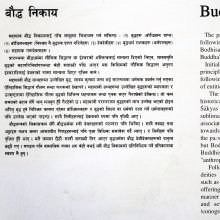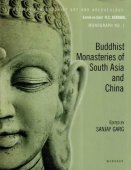Buddhist Texts: 1 definition
Introduction:
Buddhist Texts means something in Buddhism, Pali. If you want to know the exact meaning, history, etymology or English translation of this term then check out the descriptions on this page. Add your comment or reference to a book if you want to contribute to this summary article.
Images (photo gallery)
In Buddhism
General definition (in Buddhism)
Source: WikiPedia: BuddhismBuddhist texts can be categorized in a number of ways. The Western terms "scripture" and "canonical" are applied to Buddhism in inconsistent ways by Western scholars: for example, one authority refers to "scriptures and other canonical texts", while another says that scriptures can be categorized into canonical, commentarial and pseudo canonical. A rather more definite division is that between Buddhavacana (the Word of the Buddha) and other texts. The former, including the Sutras (Sanskrit) or Suttas (Pali), are held to be the literal words of the historical Buddha or close approximations thereof. The latter are the various commentaries on canonical texts and other treatises on the Dharma, as well as collections of quotations, histories, grammars, and other texts. Sometimes texts that are considered commentaries by some are regarded by others as Buddhavacana. Within Buddhavacana, there is a chronological difference between the early Buddhist texts (e.g. the Pali Canon and the Agamas), and the Mahayana sutras. Whereas some scholars believe that some portions of the Pali Canon and Agamas could contain the actual substance of the historical teachings (and possibly even the words) of the Buddha, this is not the case for the Mahayana sutras, for which only adherence to the spirit of the Buddha would be claimed by non fundamentalist Mahayanists.
See also (Relevant definitions)
Partial matches: Buddhist.
Full-text (+567): Ajitakesakambala, Vinayapitaka, Arthavargiya, Atmospheric deity, Cloud god, Danashila, Rashtra, Geya, Tissavapi, Kalasila, Kalyani, Mahaganga, Indakuta, Manihira, Thuparama, Veluvana, Raga, Gambhiranadi, Kukkutarama, Manipabbata.
Relevant text
Search found 65 books and stories containing Buddhist Texts; (plurals include: Buddhist Textses). You can also click to the full overview containing English textual excerpts. Below are direct links for the most relevant articles:
Bihar and Eastern Uttar Pradesh (early history) (by Prakash Narayan)
Empirical Relevance of Vanna, Jati and Kula < [Chapter 4 - Social Process, Structures and Reformations]
High and Low strata in Buddhist texts < [Chapter 4 - Social Process, Structures and Reformations]
The Significance of the Gahapati in the Buddhist View of Stratification < [Chapter 4 - Social Process, Structures and Reformations]
Bhesajjakkhandhaka (Chapter on Medicine) (by Hin-tak Sik)
Literature Review < [Chapter 1 - Introduction]
Outlines of Chapters < [Chapter 1 - Introduction]
Conclusion: Summary of Present Research < [Chapter 6 - Conclusion]
Maha Prajnaparamita Sastra (by Gelongma Karma Migme Chödrön)
Preliminary note on the Eleven Knowledges < [Part 1 - The eleven knowledges (jñāna, ñāṇa)]
Preliminary note (3): Explanations on the aṅgas < [Part 2 - Hearing the twelve-membered speech of the Buddha]
Part 5 - Explanation of the word ‘samaye’ < [Chapter II - Evam Mayā Śrutam Ekasmin Samaye]
Bodhisattvacharyavatara (by Andreas Kretschmar)
Text Section 146 < [Khenpo Chöga’s Oral Explanations]
Text Sections 130-131 < [Khenpo Chöga’s Oral Explanations]
Text Section 117 < [Khenpo Chöga’s Oral Explanations]
A Historical Study of Kaushambi (by Nirja Sharma)
Religion and Society of Kaushambi < [Chapter 1]
Historical Background of Kaushambi < [Chapter 2]
Tibet (Myth, Religion and History) (by Tsewang Gyalpo Arya)
2. Royal Patronage and the Teachings < [Chapter 7 - Buddhism in Tibet]
5. Persecution and the Decline < [Chapter 6 - Tonpa Shenrab Mibo and Bon Religion]
7. The Myth of Cosmic Egg < [Chapter 1 - Early Tibetan Origin Myth]
Related products


